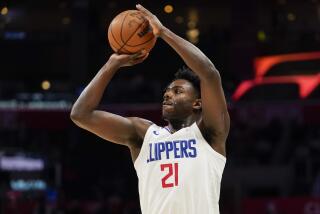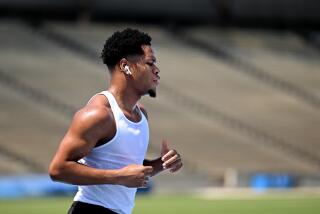Toughest Opponent Has Been Himself : Charlie Brown Tries to Prove Heās More Than Just a Good Man
They call boxer Charlie Brown āWhite Lightning,ā which is just fine with Charlie Brown.
As boxing nicknames go, itās not all that bad. Besides, itās better than being called washed up.
Brown has been called that, too. And at a very young age. Thatās whyās bounced from New Jersey to Las Vegas to North Hollywood, where he is training with Ten Goose boxing.
At the age of 20, and after only three years as a professional, Charlie Brown is on the comeback trail.
Heās out to prove the people who said he could never be a winner again were wrong. And those people who said he was a good fighter, but couldnāt handle success? Heās says theyāre wrong too.
Itās mid afternoon on a warm summer weekday at the Ten Goose gym. It is here that Charlie Brown goes through his own purgatory.
It is here that he tries to atone for the good times of the past. The times he stayed out until the wee hours of the morning, drinking, eating, and basically being a good-time Charlie.
Heās paying for it now, in sweat.
He works out six days a week, running four to five miles a day, sparring six rounds, jumping rope, punching bags and doing sit ups.
And sometimes, he suffers just thinking of what might have been.
Brown was labeled āWhite Lightningā by a couple of the young black kids who use to hang around the Gleason gym in Manhattan and watch the pro fighters work out. āThey said they had never seen a white guy with faster hands,ā Brown says proudly.
If those kids thought Brown was fast in the ring, they should have seen him dancing disco inside the Studio 54 night club. Especially after a few drinks.
Brown had just about everything a bachelor in the Big Apple could possibly ask for.
He was celebrity, having already fought on national television on several occasions. He was good looking, too, and he had a reputation of being able to find a good time.
Money? He was making a lot, and he was willingly to part with it.
Said Brown: āI used to go out about three times a week and drink and party until around two or three oāclock in the morning. When I was training, Iād only stay out Friday and Saturday night, but if I had time off Iād go almost every night. My weight would go from 135 to 155, practically all because of drinking. I was destroying my body.ā
His reputation as a fighter was also crumbling. Boxing promoters, managers and trainers took turns whispering to each other that Brownās career had succumbed to the lure of booze.
In the ring, however, Brown was surviving rather well. He won his first 23 professional fights and earned himself a title bout against former International Boxing Federation champion Harry Arroyo. Brownās share of the purse: $65,000. It was the biggest fight of his life.
It became his first loss.
Brown won the first five rounds on all three judgesā cards, but Arroyo came back to stop him in the eighth.
It was after that fight that a financial dispute Brown and New Jersey-based fight manager Lenny Shaw came to a head. Brown said goodby and headed for Las Vegas to work with Eddie Futch, the trainer of Larry Holmes. Shaw said good riddance.
Six months later, Brown met an unknown named Harold Brazier in a bout at Lake Tahoe. His share of the purse: $5,000. He lost again.
āIt really hit me just how far I had fallen after that fight,ā Brown said. āI realized that after fighting for $65,000, I was fighting for $5,000 and on my way down from there. It was time for me to look in the mirror and when I did, I didnāt like what I saw. I remember talking to my mom after losing. My eyes and face were all beaten up and swollen. She said to me, āCharlie, if boxing is going to make you look like that, maybe itās time to get out of boxing.ā I agreed.ā
Brown made a decision, but it wasnāt to hang up the gloves. Instead, he vowed to get in shape and make the next guy walk away scarred and swollen. Futch, Brown concluded, was spending too much time running around the country to work with other fighters. He needed some individual attention. He needed a manager and a trainer who believed he could make it back to the top and were willing to work as hard as he was. Which is where Ten Goose entered the picture.
Bob Surkein, former president of the American Boxing Federation, recommended Ten Goose to Brown and Brown to Ten Goose.
After meeting Dan Goossen, Ten Gooseās manager, and his brother Joe, the trainer, Brown signed a contract. No signing bonus, just a warning.
āOne of the first things I told him was, āNo booze. One beer and youāre out of here,ā ā Dan Goossen said. āThat was our deal. He knew what we wanted before he signed with us. He said he had goals. We said that if he came out here and worked his butt off, heād attain those goals.
āI had heard the rumors. People were saying he had a drinking problem. Others said he was into drugs. We made some calls and we talked to a lot of people. Not all of what we heard was positive.
āBut we talked to him about it. We got to hear his side. He was young, living alone, and he was making a lot of money. A lot of people would, and have, made the same kind of mistakes he did. What really mattered to us was his attitude now. We told him he was coming out here to box and nothing else.ā
The man in charge of keeping Brown on the right track is Joe Goossen, who says he was not intimidated by the reputation that proceeded Brownās arrival.
āWhat they said about Charlie didnāt surprise me,ā Joe Goossen said. āIt happens to a lot of fighters--too much, too fast. What I see in Charlie is a man who knows his mistakes and is looking to get back on top. I think thatās why heās out here--to start over again and stay on the right path. Iāve seen a lot of dedication on his part. His reputation before doesnāt matter. All I know for sure is that heās up every morning at 5:30 to run. Six days a week, heās in the gym. So far, heās stayed the course, and if he keeps it up heās only about two months away from being ready to fight a top ten opponent.ā
Brown checked into the Goossen camp four weeks ago weighing 155 pounds. Heās down to 143. He should be about 140 when he steps into the ring Tuesday in a junior welterweight bout against Ted Michaliszyn (12-3) of Las Vegas at the Country Club in Reseda.
Dan Goossen says Brown has shown a normal amount of rust after three months off.
āWhat were doing is putting him through kind of a spring training,ā Dan Goossen said. āWeāre going over all the fundamentals step by step. And weāre doing a lot of conditioning--without any complaints from Charlie. In fact, about a week ago he told Joe and I heād like to run a little harder.
āBob (Surkein) called again today, asking about Charlieās progress. I said, āBob, weāre proud to have him.ā ā
Dan Goossenās hopes Brown can quickly return to his old form. He feels he has an up and coming star in welterweight Michael Nunn, but Brown, who has been ranked in the top ten before, can give him an immediate contender.
āCharlie has already shown he can fight with a champion (Arroyo),ā Dan Goossen said. āIf he can beat a champion for five rounds, thereās no reason he canāt do it for 10 or 15. Our job is to give him those extra rounds of training and confidence.
āHeās been on national television three times and ESPN on several other occasions. Heās good looking. He speaks well. If we can get him going again, TV will be just around the corner. This is a great opportunity--for Charlie Brown, and for Ten Goose boxing. I know what we can do. I just hope he does what heās capable of doing. If he does, weāll have that championship weāve been working for.
āPeople were telling me that he might be washed up. Well, heās 20 years old, he has a 23-2 record and heās out here working his tail off. At this point you could say Iām pretty darn sure heās not through. In fact, Iām banking on it.ā
More to Read
Go beyond the scoreboard
Get the latest on L.A.'s teams in the daily Sports Report newsletter.
You may occasionally receive promotional content from the Los Angeles Times.











